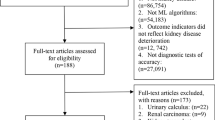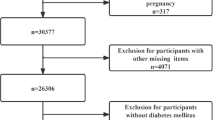Abstract
Background
Machine learning is increasingly recognized as a viable approach for identifying risk factors associated with diabetic kidney disease (DKD). However, the current state of real-world research lacks a comprehensive systematic analysis of the predictive performance of machine learning (ML) models for DKD.
Objectives
The objectives of this study were to systematically summarize the predictive capabilities of various ML methods in forecasting the onset and the advancement of DKD, and to provide a basic outline for ML methods in DKD.
Methods
We have searched mainstream databases, including PubMed, Web of Science, Embase, and MEDLINE databases to obtain the eligible studies. Subsequently, we categorized various ML techniques and analyzed the differences in their performance in predicting DKD.
Results
Logistic regression (LR) was the prevailing ML method, yielding an overall pooled area under the receiver operating characteristic curve (AUROC) of 0.83. On the other hand, the non-LR models also performed well with an overall pooled AUROC of 0.80. Our t-tests showed no statistically significant difference in predicting ability between LR and non-LR models (t = 1.6767, p > 0.05).
Conclusion
All ML predicting models yielded relatively satisfied DKD predicting ability with their AUROCs greater than 0.7. However, we found no evidence that non-LR models outperformed the LR model. LR exhibits high performance or accuracy in practice, while it is known for algorithmic simplicity and computational efficiency compared to others. Thus, LR may be considered a cost-effective ML model in practice.



Similar content being viewed by others
Abbreviations
- Area under the receiver operating characteristic curve:
-
AUROC
- Biological age:
-
BA
- Body mass index:
-
BMI
- Chronological age:
-
CA
- Concordance index:
-
C-index
- Creatinine:
-
Cr
- Diabetic kidney disease:
-
DKD
- Estimated Glomerular Filtration Rate:
-
eGFR
- False negatives:
-
FN
- False positives:
-
FP
- Kidney Age Index:
-
KAI
- Logistic regression:
-
LR
- Low-Density Lipoprotein Cholesterol:
-
LDL-C
- Machine learning:
-
ML
- Prediction Model Risk of Bias Assessment Tool:
-
PROBAST
- Synthetic Minority Over-sampling Technique:
-
SMOTE
- Summary ROC:
-
SROC
- Systolic blood pressure:
-
SBP
- Transparent Reporting of a Multivariate Predictive Models for Individual Prognosis or Diagnosis:
-
TRIPOD
- True negatives:
-
TN
- True positives:
-
TP
- True negative rate:
-
TNR
- True positive rate:
-
TPR
- Urine Albumin Creatinine Ratio:
-
UACR
References
M.C. Thomas, M. Brownlee, K. Susztak et al. Diabetic kidney disease. Nat. Rev. Dis. Prim. 1, 15018 (2015)
R.C. Slieker, A.A.W.A. Van Der Heijden, M.K. Siddiqui et al. Performance of prediction models for nephropathy in people with type 2 diabetes: systematic review and external validation study. BMJ (Clin. Res. ed.) 374, n2134 (2021)
L. Winter, L.A. Wong, G. Jerums et al. Use of readily accessible inflammatory markers to predict diabetic kidney disease. Front Endocrinol. 9, 225 (2018)
Fernandes J, Bissaro L, Santos F, et al. Deep learning in risk assessment. An. XVI Encontro Nac. Intel. Artif. Comput. (2019). https://doi.org/10.5753/eniac.2019.9358
X. Song, X. Liu, F. Liu et al. Comparison of machine learning and logistic regression models in predicting acute kidney injury: a systematic review and meta-analysis. Int. J. Med. Inform. 151, 104484 (2021)
Z. Zhang, L. Yang, W. Han et al. Machine learning prediction models for gestational diabetes mellitus: meta-analysis. J. Med. Internet Res. 24(3), e26634 (2022)
R.A.M. Guidotti, Anna, Ruggieri, Salvatore, Turini et al. A survey of methods for explaining black box models. ACM Comput. Surv. 51, 0360–0300 (2018)
D. Ahmedt-Aristizabal, M.A. Armin, S. Denman et al. Graph-based deep learning for medical diagnosis and analysis: past, present and future. Sensors 21, 14 (2021)
E. Christodoulou, J. Ma, G.S. Collins et al. A systematic review shows no performance benefit of machine learning over logistic regression for clinical prediction models. J. Clin. Epidemiol. 110, 12–22 (2019)
Y.-H. Pua, H. Kang, J. Thumboo et al. Machine learning methods are comparable to logistic regression techniques in predicting severe walking limitation following total knee arthroplasty. Knee Surg. Sports Traumatol. Arthrosc. 28(10), 3207–16 (2020)
W.A. Van Eeden, C. Luo, A.M. Van Hemert et al. Predicting the 9-year course of mood and anxiety disorders with automated machine learning: a comparison between auto-sklearn, naïve Bayes classifier, and traditional logistic regression [J]. Psychiatry Res. 299, 113823 (2021)
G.H. Li, C.L. Cheung, K.C. Tan et al. Development and validation of sex-specific hip fracture prediction models using electronic health records: a retrospective, population-based cohort study. EClinicalMedicine 58, 101876 (2023)
M.D.F. Mcinnes, D. Moher, B.D. Thombs et al. Preferred reporting items for a systematic review and meta-analysis of diagnostic test accuracy studies: the PRISMA-DTA statement. JAMA 319(4), 388–96 (2018)
L.M. Fleuren, T.L.T. Klausch, C.L. Zwager et al. Machine learning for the prediction of sepsis: a systematic review and meta-analysis of diagnostic test accuracy. Intensive Care Med. 46(3), 383–400 (2020)
G.S. Collins, J.B. Reitsma, D.G. Altman et al. Transparent reporting of a multivariable prediction model for individual prognosis or diagnosis (TRIPOD): the TRIPOD statement. BMJ (Clin. Res. ed.) 350, g7594 (2015)
K.G.M. Moons, J.A.H. De Groot, W. Bouwmeester et al. Critical appraisal and data extraction for systematic reviews of prediction modelling studies: the CHARMS checklist. PLoS Med. 11(10), e1001744 (2014)
K.G.M. Moons, R.F. Wolff, R.D. Riley et al. PROBAST: a tool to assess risk of bias and applicability of prediction model studies: explanation and elaboration [J]. Ann. Intern. Med. 170(1), W1–W33 (2019)
C. Krittanawong, H.U.H. Virk, S. Bangalore et al. Machine learning prediction in cardiovascular diseases: a meta-analysis [J]. Sci. Rep. 10(1), 16057 (2020)
Y. Zou, L. Zhao, J. Zhang et al. Development and internal validation of machine learning algorithms for end-stage renal disease risk prediction model of people with type 2 diabetes mellitus and diabetic kidney disease [J]. Ren. Fail. 44(1), 562–70 (2022)
A. Allen, Z. Iqbal, A. Green-Saxena et al. Prediction of diabetic kidney disease with machine learning algorithms, upon the initial diagnosis of type 2 diabetes mellitus [J]. BMJ open diabetes Res. care 10(1), e002560 (2022)
S. Belur Nagaraj, M.J. Pena, W. Ju et al. Machine-learning-based early prediction of end-stage renal disease in patients with diabetic kidney disease using clinical trials data [J]. Diabetes, Obes. Metab. 22(12), 2479–86 (2020)
B.H. Cho, H. Yu, K.-W. Kim et al. Application of irregular and unbalanced data to predict diabetic nephropathy using visualization and feature selection methods [J]. Artif. Intell. Med. 42(1), 37–53 (2008)
Z. Dong, Q. Wang, Y. Ke et al. Prediction of 3-year risk of diabetic kidney disease using machine learning based on electronic medical records [J]. J. Transl. Med. 20(1), 143 (2022)
Y.-M. Gao, S.-T. Feng, Y. Yang et al. Development and External Validation of a Nomogram and a Risk Table for Prediction of Type 2 Diabetic Kidney Disease Progression Based on a Retrospective Cohort Study in China [J]. Diabetes, Metab. Syndr. Obes.: Targets Ther. 15, 799–811 (2022)
S. Jiang, J. Fang, T. Yu et al. Novel Model Predicts Diabetic Nephropathy in Type 2 Diabetes [J]. Am. J. Nephrol. 51(2), 130–8 (2020)
S. Low, S.C. Lim, X. Zhang et al. Development and validation of a predictive model for Chronic Kidney Disease progression in Type 2 Diabetes Mellitus based on a 13-year study in Singapore [J]. Diabetes Res. Clin. Pract. 123, 49–54 (2017)
M. Makino, R. Yoshimoto, M. Ono et al. Artificial intelligence predicts the progression of diabetic kidney disease using big data machine learning [J]. Sci. Rep. 9(1), 11862 (2019)
V. Rodriguez-Romero, R.F. Bergstrom, B.S. Decker et al. Prediction of Nephropathy in Type 2 Diabetes: An Analysis of the ACCORD Trial Applying Machine Learning Techniques [J]. Clin. Transl. Sci. 12(5), 519–28 (2019)
X. Song, L.R. Waitman, Y. Hu et al. Robust clinical marker identification for diabetic kidney disease with ensemble feature selection [J]. J. Am. Med. Inform. Assoc.: JAMIA 26(3), 242–53 (2019)
L. Sun, J. Shang, J. Xiao et al. Development and validation of a predictive model for end-stage renal disease risk in patients with diabetic nephropathy confirmed by renal biopsy [J]. PeerJ 8, e8499 (2020)
H. Tong, D. Wang, M. Fang, Correlation between Glucose/C-Peptide Ratio and the Risk of Disease Progression in Diabetic Nephropathy Patients: A Clinical Retrospective Analysis [J]. J. Healthc. Eng. 2022, 7406764 (2022)
C. Xi, C. Wang, G. Rong et al. A Nomogram Model that Predicts the Risk of Diabetic Nephropathy in Type 2 Diabetes Mellitus Patients: A Retrospective Study [J]. Int. J. Endocrinol. 2021, 6672444 (2021)
D. Hui, F. Zhang, Y. Lu et al. A Multifactorial Risk Score System for the Prediction of Diabetic Kidney Disease in Patients with Type 2 Diabetes Mellitus [J]. Diabetes, Metab. Syndr. Obes.: Targets Ther. 16, 385–95 (2023)
L. Chan, G.N. Nadkarni, F. Fleming et al. Derivation and validation of a machine learning risk score using biomarker and electronic patient data to predict progression of diabetic kidney disease [J]. Diabetologia 64(7), 1504–15 (2021)
S.M. Hosseini Sarkhosh, M. Hemmatabadi, A. Esteghamati, Development and validation of a risk score for diabetic kidney disease prediction in type 2 diabetes patients: a machine learning approach [J]. J. Endocrinological Investig. 46(2), 415–23 (2023)
W. Jiang, J. Wang, X. Shen et al. Establishment and Validation of a Risk Prediction Model for Early Diabetic Kidney Disease Based on a Systematic Review and Meta-Analysis of 20 Cohorts [J]. Diabetes Care 43(4), 925–33 (2020)
S.M. Hosseini Sarkhosh, A. Esteghamati, M. Hemmatabadi et al. Predicting diabetic nephropathy in type 2 diabetic patients using machine learning algorithms [J]. J. Diabetes Metab. Disord. 21(2), 1433–41 (2022)
L. Sun, Y. Wu, R.-X. Hua et al. Prediction models for risk of diabetic kidney disease in Chinese patients with type 2 diabetes mellitus [J]. Ren. Fail. 44(1), 1454–61 (2022)
C. Sabanayagam, F. He, S. Nusinovici et al. Prediction of diabetic kidney disease risk using machine learning models: A population-based cohort study of Asian adults [J]. eLife 12, e81878 (2023)
S.-M. Ou, M.-T. Tsai, K.-H. Lee et al. Prediction of the risk of developing end-stage renal diseases in newly diagnosed type 2 diabetes mellitus using artificial intelligence algorithms [J]. BioData Min. 16(1), 8 (2023)
Y. Cheng, J. Shang, D. Liu et al. Development and validation of a predictive model for the progression of diabetic kidney disease to kidney failure [J]. Ren. Fail. 42(1), 550–9 (2020)
R.D. Riley, J. Ensor, K.I.E. Snell et al. Calculating the sample size required for developing a clinical prediction model [J]. BMJ (Clin. Res. ed.) 368, m441 (2020)
L. Wang, Y. Wang, Q. Chang, Feature selection methods for big data bioinformatics: A survey from the search perspective [J]. Methods 111, 21–31 (2016)
T. Wang, A. Bezerianos, A. Cichocki et al. Multikernel Capsule Network for Schizophrenia Identification [J]. IEEE Trans. Cybern. 52(6), 4741–50 (2022)
S. Nusinovici, Y.C. Tham, M.Y. Chak Yan et al. Logistic regression was as good as machine learning for predicting major chronic diseases [J]. J. Clin. Epidemiol. 122, 56–69 (2020)
S.P. Silveiro, R. Friedman, M.J. De Azevedo et al. Five-year prospective study of glomerular filtration rate and albumin excretion rate in normofiltering and hyperfiltering normoalbuminuric NIDDM patients [J]. Diabetes Care 19(2), 171–4 (1996)
H.J. Thomson, E.I. Ekinci, N.J. Radcliffe et al. Elevated baseline glomerular filtration rate (GFR) is independently associated with a more rapid decline in renal function of patients with type 1 diabetes. J. Diabetes Complications 30(2), 256–61 (2016)
A. Ceriello, F. Prattichizzo, Variability of risk factors and diabetes complications. Cardiovasc. Diabetol. 20(1), 101 (2021)
L. Tonneijck, M.H.A. Muskiet, M.M. Smits et al. Glomerular hyperfiltration in diabetes: mechanisms, clinical significance, and treatment. J. Am. Soc. Nephrol. 28(4), 1023–39 (2017)
M.C. Thomas, R.C. Atkins, Blood pressure lowering for the prevention and treatment of diabetic kidney disease. Drugs 66(17), 2213–34 (2006)
C.L. Andaur Navarro, J.A.A. Damen, T. Takada et al. Risk of bias in studies on prediction models developed using supervised machine learning techniques: systematic review. BMJ (Clin. Res. ed.) 375, n2281 (2021)
C.L. Andaur Navarro, J.A.A. Damen, T. Takada et al. Completeness of reporting of clinical prediction models developed using supervised machine learning: a systematic review. BMC Med. Res. Methodol. 22(1), 12 (2022)
Acknowledgements
The authors thank the staff and participants of the study for their indispensable contributions.
Funding
This study was funded by Tianjin Science and Technology Major Special Project and Engineering Public Health Science and Technology Major Special Project (No.21ZXGWSY00100), Tianjin Natural Science Foundation Key Projects (No.22JCZDJC00590), Tianjin Key Medical Discipline (Specialty) Construct Project (No.TJYXZDXK-032A), Scientific Research Funding of Tianjin Medical University Chu Hsien-I Memorial Hospital (No.ZXY-ZDSYSZD-1), China Endocrine Metabolism Talent Research Fund (No. 2022-N-02-07). The funder was not for profit.
Author information
Authors and Affiliations
Contributions
L.C. and X.S. contributed equally to this study. L.C. and X.S. acquired the data, prepared the Figs, and wrote the manuscript; P.Y. designed this study and revised the manuscript. All authors read and approved the final manuscript.
Corresponding author
Ethics declarations
Conflict of interest
The authors declare no competing interests.
Consent to publish
Written informed consent for publication was obtained from all participants. All authors agree to be accountable for all aspects of the work in ensuring that questions related to the accuracy or integrity of any part of the work are appropriately investigated and resolved. The meta-analysis was registered on PROSPERO (reference number CRD 42022357770).
Additional information
Publisher’s note Springer Nature remains neutral with regard to jurisdictional claims in published maps and institutional affiliations.
Supplementary information
Rights and permissions
Springer Nature or its licensor (e.g. a society or other partner) holds exclusive rights to this article under a publishing agreement with the author(s) or other rightsholder(s); author self-archiving of the accepted manuscript version of this article is solely governed by the terms of such publishing agreement and applicable law.
About this article
Cite this article
Chen, L., Shao, X. & Yu, P. Machine learning prediction models for diabetic kidney disease: systematic review and meta-analysis. Endocrine (2023). https://doi.org/10.1007/s12020-023-03637-8
Received:
Accepted:
Published:
DOI: https://doi.org/10.1007/s12020-023-03637-8




